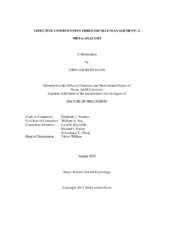| dc.description.abstract | The current study examines aspects of Self-managed (SM) interventions for behavior. SM is a multi-component intervention where students are active participants in the process of improving their behavior. Despite substantial research supporting the use of this intervention in schools, there is currently a lack of consensus regarding which procedures are necessary to implement this intervention. Methods for evaluating evidence based practice (EBP) place an emphasis on clearly identifiable intervention procedures. Therefore, a review of SM literature is necessary to determine if sufficient supportive evidence exists to promote various versions of SM as an EBP. In addition, an analysis is necessary to determine which intervention components are essential and how the addition or removal of components relates to student outcomes.
The current study is a meta-analytic review of single case research literature. In reviewing the presence of intervention components, the current study found that 18 unique combinations of intervention components occur within SM literature. When disaggregated based on student responsibility for implementing intervention components, the number of unique combinations of intervention procedures grew to 44. Application of current EBP criteria found that four of versions of the SM intervention met criteria.
Examination of student factors found differential effects based on student disability classification, age, and the targeted outcome. No effects were found within the educational setting variable.
Examination of additional intervention procedures found that the use of external reinforcement and assessment of student accuracy is not related to improved outcomes. In addition, the method of cueing self-recording is not related to differential effects.
In sum, the current analysis shows that SM is a highly effective intervention for school age children across a variety of behavioral targets. In terms of implementation, the current analysis shows that much of SM’s effects are based two key components (e.g. self-assessment and self-recording). The current analysis also shows that many of the procedures commonly associated with this intervention do not contribute to improved outcomes. | en |


